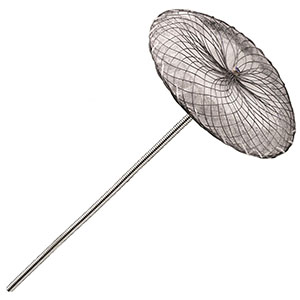Minimally-invasive implant closes congenital hole in heart without surgery
The Heart Hospital at St. Joseph’s/Candler is the first in the region to use a new minimally-invasive implant to close a hole in a patient’s heart.
The implant, called the St. Jude Amplatzer Septal Occluder, can be used to correct one of two conditions: Atrial Septal Defect (ASD) and Patent Foramen Ovale (PFO) which are both 10 to 30 millimeter holes between the top chambers of the heart. In the case of ASD, this hole can cause too much blood to flow in the wrong direction. Over time, this can cause heart failure.
This minimally-invasive implant procedure can stop the risk of strokes and give patients their lives back without open surgery or a long hospital stay.
How the procedure works

Just like the process St. Joseph’s/Candler specialists use to open up blocked arteries or replace a heart valve, doctors use a catheter to guide a special implant through an incision in the leg. The St. Jude Amplatzer Septal Occluder – a two-disk, button-shaped implant – sits inside a catheter as it travels up into the heart.
Using a flourascope and intracardiac ultrasound, a specially-trained cardiologist carefully positions the implant through the hole in the heart and then expands the two sides of the disc until the middle part of the implant rests snuggly against the heart wall. The result is like cuff links or buttons filling the holes on a shirt.
Patients typically go home within one to two days following the procedure. In about 95 percent of patients, the hole is closed immediately. Over a period of five to six months, the lining of the heart grows completely over this.
Not all patients with a hole in their heart would benefit from surgery. It depends on the size of the hole, the patient’s symptoms and how they impact their quality of life.
The Patient Experience
A 57-year-old woman was experiencing shortness of breath. Her cardiologist found she had a hole in her heart and referred her to Atlanta for a closure procedure. The woman did not want to travel that far for treatment.
As her heart enlarged to compensate for her blood flowing in the wrong direction through the hole in her heart, her shortness of breath continued to worsen. Closure by this device was recommended based on the size of the hole and the progression of her symptoms.
The woman was successfully treated and returned home to her family the next day. She is the first patient to receive the implant in the region. She’s seeing gradual improvement in her symptoms. These symptoms are expected to continue to improve as her heart adapts to the closure and begins to return to its normal function and size.
A second St. Jude Amplatzer Septal Occluder implant procedure was successfully performed on an active 76-year-old man. A blood clot was discovered in his leg when he was admitted to the hospital following a stroke. The man continued to experience a series of strokes despite being on blood thinners. A PFO was discovered following cardiac imaging and heart implant closure was recommended.
The patient was successfully treated and returned home following an overnight stay at St. Joseph’s Hospital. He reports he’s doing well.
